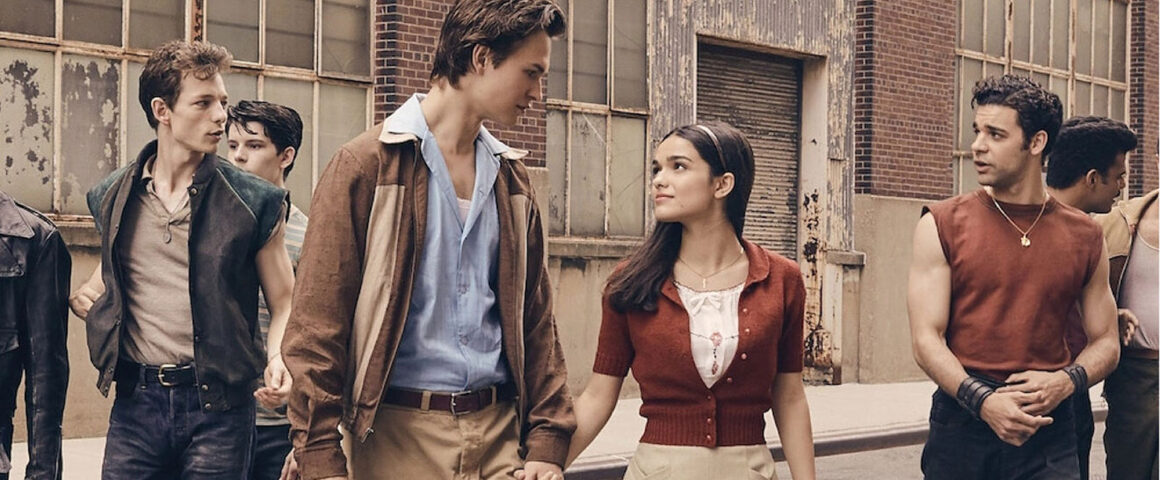West Side Story 2021 might just be a perfect film. This is no mean feat considering the stunning stage musical as well as the equally perfect big screen adaptation from 1961. The new version proves equal to the challenge of adapting the beloved property, as 60 years after Robert Wise and Jerome Robbins delivered their Oscar-winning masterpiece, Steven Spielberg demonstrates once again that he is among the most accomplished and versatile filmmakers working in Hollywood. Spielberg brings his skills to the musical genre with a dazzling assembly of cinematic brilliance where every aspect feels machine-tooled to enchant and exhilarate the viewer, while also being shot through with humanity.
Arthur Laurents’ story (of the West Side) is strong enough for multiple tellings, itself an adaptation of Romeo and Juliet. Screenwriter Tony Kushner updates some aspects of the story, providing backstory for Tony (Ansel Elgort, “Baby Driver”), enhancing the roles of characters such as Valentina (Rita Moreno, “Torch”) and providing additional grit. None of these aspects unbalance the tale of star-crossed lovers Tony and Maria (Rachel Zegler), respectively associated with rival gangs the white American Jets and Puerto Rican Sharks, the gang warfare itself taking place against the backdrop of gentrification.
Much of the film’s power comes from this backdrop. Racial tensions between locals and immigrants prove just as resonant in 2021 as they did in past decades, as does the gulf between economic aspirations and reality. The musical number “I Feel Pretty” takes place in a department store, where Maria adorns herself with garments in a living room display, while her cleaner’s uniform highlights the distance between how she feels and how she lives. Everything free in America, for a not so small fee indeed. These class politics are epitomized in the opening long take that captures an area marked for clearance, while also including a sign that displays the planned future development. These politics receive fullest expression in the musical number “Gee Officer Krupke,” which demonstrates both the power of song to encapsulate social ills as well as the extraordinary talents of the cast. Powerful voices swell from the frames of Elgort and especially Zegler, while Ariana DeBose (“The Prom”) dominates the frame as Anita. “A Boy Like That / I Have a Love” serves as both a duet and a duel between Ariana and Maria, anger, sorrow and love competing with each other yet exquisitely contained within their soaring voices.
Alongside the powerful vocals are some electrifying dances, and dance is possibly even more important than song here. While the major songs are memorable — “Maria,” “America” and “Tonight” have deeply penetrated the cultural consciousness — the exquisite choreography expresses individual character, community connections and social processes. Spielberg proves himself just as adept a dancer with his camera, as a veritable troupe of techniques fairly engulf the viewer. Long takes, (very) wide angles, canted frames, fast cuts, deep focus, crane shots, slow and fast motion within the same shot, all are beautifully combined in a dazzling cinematic bonanza. Musicals such as “Moulin Rouge” and “Chicago” emphasize very rapid cutting, while “Les Misérables” seems to forget that a musical beat can provide a rhythm for editing. “The Greatest Showman” and “La La Land” lean more into a classical style of letting the camera stand back so as to capture the choreography. Spielberg embraces the various approaches, shifting between highlighting the dancers to delivering a dizzying display of camera tricks, with the end result being a perfect balance between form and content.
Further aspects of the form include the production design, as Adam Stockhausen creates a New York of the 1950s that features both warm and inviting homes as well as partially demolished slums that recall the bombed ruins in “Saving Private Ryan.” Despite the elegant but powerful dances, Spielberg still allows time for the expressive power of these sets, especially during the number “Cool” that takes place against a backdrop of open blue sky, crisscrossed with the jagged grid of a broken metal superstructure. This sequence as well as “America” are especially bright, the sky alongside Paul Tazewell’s costumes vibrant and stellar. Color and lighting are also used as expressive devices, as cinematographer Janusz Kaminski varies the palette. We begin with a somewhat washed-out visual tone, before Kaminski steadily increases the range of hues and then decreases them again. The shifting visual tones reflect the emotional hues of the music and the story as a whole: A climactic confrontation between the Jets and Sharks in a salt warehouse emphasizes the white mounds as well as the dark shadows, while the final confrontation has an almost noirish look.
Within these expressive sets and shifting colors, the characters remain warm and engaging. While it is easy to sneer at the adolescent obsession of Tony and Maria, the film is careful to never do so, and the fallout of their relationship, tragic though it is, is not framed as being really their fault. If anything, they seem naïve in their belief that their forbidden romance is the cause of the conflict between the Jets and Sharks. It is tempting to draw a parallel between the self-scapegoating that Tony and Maria perform and the practice of scapegoating and demonizing immigrants, the true central tension of West Side Story. This is perhaps what makes the film perfect for the current moment. Despite its history, the tale of different groups focusing on their differences rather than responding to the forces that threaten all of them remains troublingly pertinent. The final crane shot depicts the forces of the state coming to impose order, the rungs of a fire escape visually imprisoning the little people just as they are imprisoned within the frameworks of the urban environment, class structures and capitalism. Thus, we have a story not just about the West Side, but for many places and communities around the world, a story that offers pumping tunes and emotional arcs, but also sober realities and compelling reflections.



